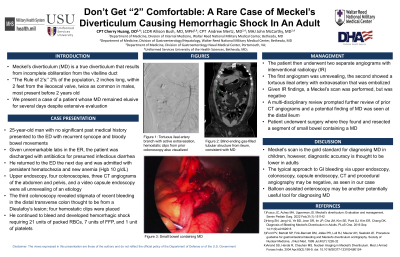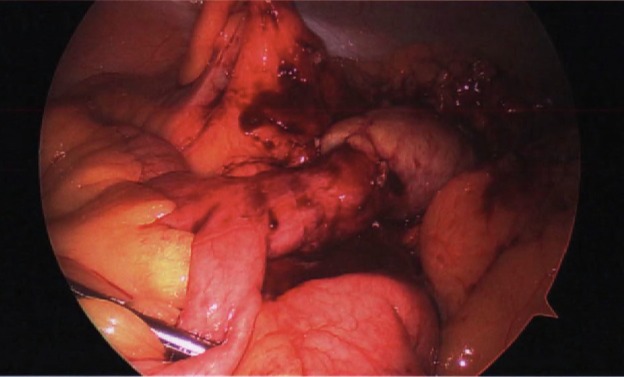Back


Poster Session A - Sunday Afternoon
Category: GI Bleeding
A0302 - Don’t Get 2 Comfortable: A Rare Case of Meckel’s Diverticulum Causing Hemorrhagic Shock in an Adult
Sunday, October 23, 2022
5:00 PM – 7:00 PM ET
Location: Crown Ballroom

Has Audio

Cherry W. Huang, DO
Walter Reed National Military Medical Center
Bethesda, MD
Presenting Author(s)
Cherry W. Huang, DO, Allison Bush, MD, Andrew Mertz, MD, John McCarthy, MD
Walter Reed National Military Medical Center, Bethesda, MD
Introduction: Meckel’s diverticulum (MD) is a true diverticulum that results from incomplete obliteration from the vitelline duct during embryonic development. It is a one of the most common congenital disorders of the gastrointestinal (GI) tract. Often characterized using “The Rule of 2’s”: MD occurs in approximately 2% of the population, is 2 inches long, is within 2 feet from the ileocecal valve, is twice as common in males than females, can contain 2 types of tissue (gastric or pancreatic), 2% become symptomatic, and most present before the age of 2. The majority of symptomatic MD occur as painless hematochezia in children and therefore is often lower on the differential of an adult with a GI bleed. Even when MD is suspected as an etiology for GI bleeding in an adult, the evaluation can be challenging.
Case Description/Methods: A 25-year-old male with no significant past medical history was admitted to the hospital for GI bleeding and then developed hemorrhagic shock requiring resuscitation with transfusion of large volumes of blood products. The etiology of his GI bleed remained elusive for several days despite evaluation with upper endoscopy, three colonoscopies, three CT angiograms of the abdomen and pelvis, and a video capsule endoscopy. Subsequently, he underwent two separate fluoroscopic angiograms with interventional radiology. While the first angiogram was unrevealing, the second angiogram demonstrated a tortuous ileal artery branch with active extravasation that was treated with embolization. Given IR findings, a Meckel’s scan was performed which was negative. A multi-disciplinary review of the case prompted further review of the patient’s abdominal CT angiogram and a potential finding of MD was seen at the distal ileum. Ultimately, the surgery team decided to take the patient to the operating room where they found and resected a segment of small bowel with tissue examination revealing the MD.
Discussion: A Meckel’s scan is often considered the modality of choice for diagnosing MD in children, however, its diagnostic accuracy is considered to be much lower in adults. The typical approach to GI bleeding via upper endoscopy, colonoscopy, capsule endoscopy, CT and procedural angiography may be negative, as seen in our case. Balloon assisted enteroscopy, where available, may also be a potentially useful tool for diagnosing MD. This case highlights the importance of maintaining a broad differential diagnosis for GI bleeding and the challenges with current diagnostic modalities.

Disclosures:
Cherry W. Huang, DO, Allison Bush, MD, Andrew Mertz, MD, John McCarthy, MD. A0302 - Don’t Get 2 Comfortable: A Rare Case of Meckel’s Diverticulum Causing Hemorrhagic Shock in an Adult, ACG 2022 Annual Scientific Meeting Abstracts. Charlotte, NC: American College of Gastroenterology.
Walter Reed National Military Medical Center, Bethesda, MD
Introduction: Meckel’s diverticulum (MD) is a true diverticulum that results from incomplete obliteration from the vitelline duct during embryonic development. It is a one of the most common congenital disorders of the gastrointestinal (GI) tract. Often characterized using “The Rule of 2’s”: MD occurs in approximately 2% of the population, is 2 inches long, is within 2 feet from the ileocecal valve, is twice as common in males than females, can contain 2 types of tissue (gastric or pancreatic), 2% become symptomatic, and most present before the age of 2. The majority of symptomatic MD occur as painless hematochezia in children and therefore is often lower on the differential of an adult with a GI bleed. Even when MD is suspected as an etiology for GI bleeding in an adult, the evaluation can be challenging.
Case Description/Methods: A 25-year-old male with no significant past medical history was admitted to the hospital for GI bleeding and then developed hemorrhagic shock requiring resuscitation with transfusion of large volumes of blood products. The etiology of his GI bleed remained elusive for several days despite evaluation with upper endoscopy, three colonoscopies, three CT angiograms of the abdomen and pelvis, and a video capsule endoscopy. Subsequently, he underwent two separate fluoroscopic angiograms with interventional radiology. While the first angiogram was unrevealing, the second angiogram demonstrated a tortuous ileal artery branch with active extravasation that was treated with embolization. Given IR findings, a Meckel’s scan was performed which was negative. A multi-disciplinary review of the case prompted further review of the patient’s abdominal CT angiogram and a potential finding of MD was seen at the distal ileum. Ultimately, the surgery team decided to take the patient to the operating room where they found and resected a segment of small bowel with tissue examination revealing the MD.
Discussion: A Meckel’s scan is often considered the modality of choice for diagnosing MD in children, however, its diagnostic accuracy is considered to be much lower in adults. The typical approach to GI bleeding via upper endoscopy, colonoscopy, capsule endoscopy, CT and procedural angiography may be negative, as seen in our case. Balloon assisted enteroscopy, where available, may also be a potentially useful tool for diagnosing MD. This case highlights the importance of maintaining a broad differential diagnosis for GI bleeding and the challenges with current diagnostic modalities.

Figure: Meckel's diverticulum at the level of distal small bowel, approximately 60cm from the ileocecal valve.
Disclosures:
Cherry Huang indicated no relevant financial relationships.
Allison Bush indicated no relevant financial relationships.
Andrew Mertz indicated no relevant financial relationships.
John McCarthy indicated no relevant financial relationships.
Cherry W. Huang, DO, Allison Bush, MD, Andrew Mertz, MD, John McCarthy, MD. A0302 - Don’t Get 2 Comfortable: A Rare Case of Meckel’s Diverticulum Causing Hemorrhagic Shock in an Adult, ACG 2022 Annual Scientific Meeting Abstracts. Charlotte, NC: American College of Gastroenterology.
